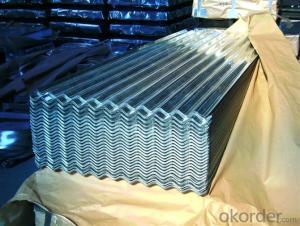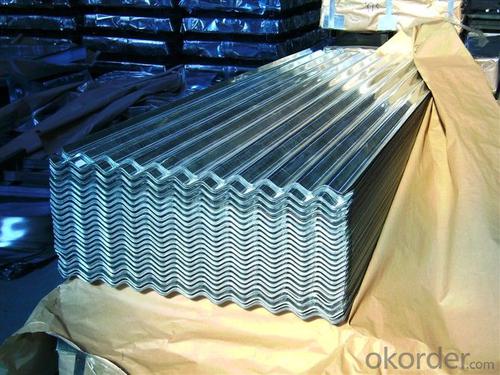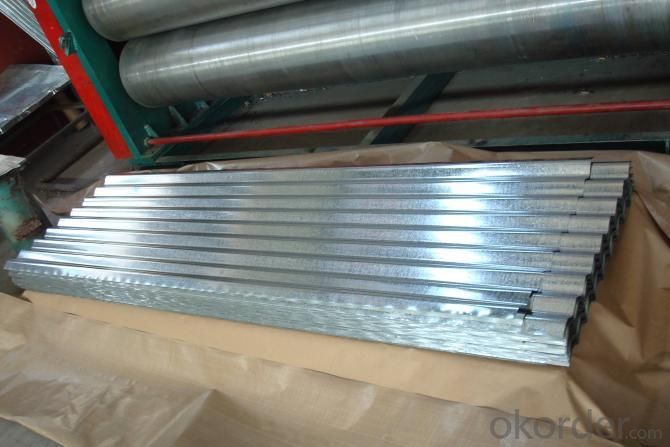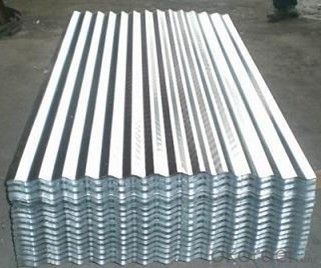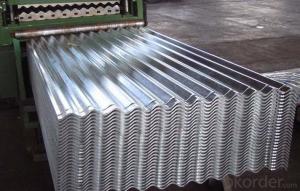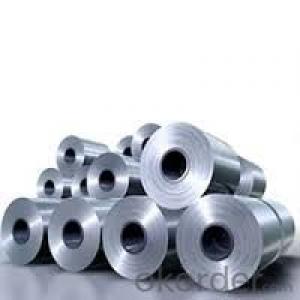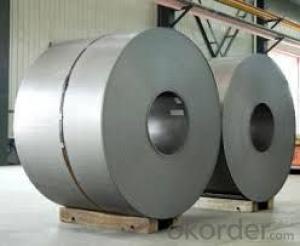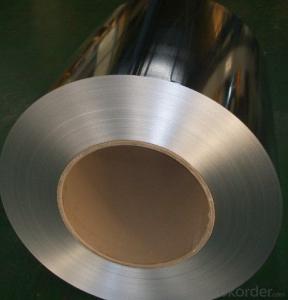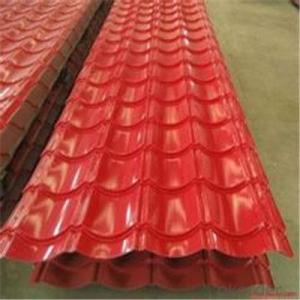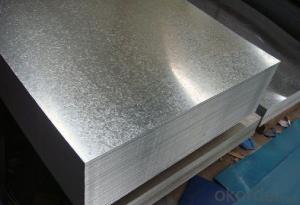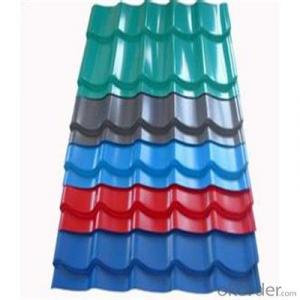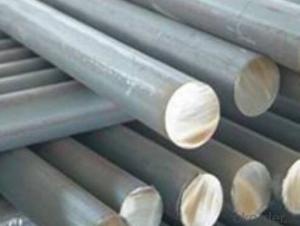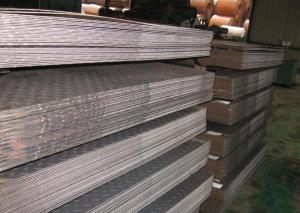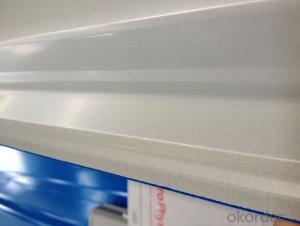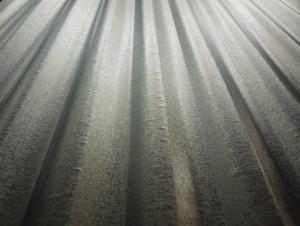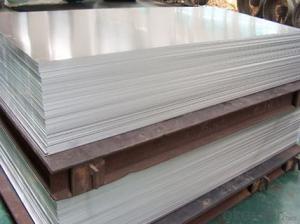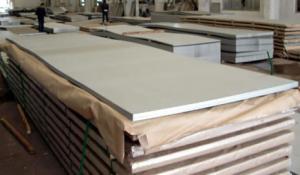Hot-dip Zinc Coating Steel Building Roof Sheets Prime Quality
- Loading Port:
- Tianjin
- Payment Terms:
- TT OR LC
- Min Order Qty:
- 50 m.t.
- Supply Capability:
- 10000 m.t./month
OKorder Service Pledge
OKorder Financial Service
You Might Also Like
1.Structure of Hot-Dip Galvanized Steel Sheet Description:
Hot-dip galvanized steel coils are available with a pure zinc coating through the hot-dip galvanizing process. It offers the economy, strength and formability of steel combined with the corrosion resistance of zinc. The hot-dip process is the process by which steel gets coated in layers of zinc to protect against rust. It is especially useful for countless outdoor and industrial applications. Production of cold formed corrugated sheets and profiles for roofing, cladding, decking, tiles, sandwich walls, rainwater protective systems, air conditioning duct as well as electrical appliances and engineering.
2.Main Features of the Hot-Dip Galvanized Steel Sheet:
• Excellent process capability
• Smooth and flat surface
• Workability, durability
• Excellent anticorrosive property
• High strength
• Good formability
• Good visual effect
3.Hot-Dip Galvanized Steel Sheet Images

4.Hot-Dip Galvanized Steel Sheet Specification
Standard: ASTM, JIS,EN
Grade: CS, DX51D+Z,SGCC, SS 230~550,S220GD+Z~S550GD+Z, SGC340~SGC570
Thickness: 0.1mm~5mm
Width: max 2000mm
Coil weight:3-12 MT
Coil ID:508/610mm
Surface structure: zero spangle, regular spangle or minimum spangle
Surface treatment: Chromate treatment, Oiled/dry, skinpassed/non-skinpassed
Packing: Standard seaworthy export package
Technology test results:
Processability | Yield strength | Tensile strength | Elongation % | 180°cold-bending |
Common PV | - | 270-500 | - | d=0,intact,no zinc removal |
Mechanical interlocking JY | - | 270-500 | - | d=0,intact,no zinc removal |
Structure JG | >=240 | >=370 | >=18 | d=0,intact,no zinc removal |
Deep drawn SC | - | 270-380 | >=30 | d=0,intact,no zinc removal |
EDDQ SC | - | 270-380 | >=30 | d=0,intact,no zinc removal |
5.FAQ of Hot-Dip Galvanized Steel Sheet
We have organized several common questions for our clients,may help you sincerely:
1.How about your company?
A world class manufacturer & supplier of castings forging in carbon steel and alloy steel,is one of the large-scale professional investment casting production bases in China,consisting of both casting foundry forging and machining factory. Annually more than 8000 tons Precision casting and forging parts are exported to markets in Europe,America and Japan. OEM casting and forging service available according to customer’s requirements.
2.How to guarantee the quality of the products?
We have established the international advanced quality management system,every link from raw material to final product we have strict quality test;We resolutely put an end to unqualified products flowing into the market. At the same time, we will provide necessary follow-up service assurance.
3. How long can we receive the product after purchase?
Usually within thirty working days after receiving buyer’s advance payment or LC. We will arrange the factory manufacturing as soon as possible. The cargo readiness usually takes 15-30 days, but the shipment will depend on the vessel situation.
- Q: Are steel sheets suitable for decorative applications?
- Yes, steel sheets are suitable for decorative applications. They can be easily shaped, cut, and finished to create various decorative elements such as wall panels, furniture, sculptures, and architectural features. Steel sheets also offer durability, strength, and a modern aesthetic, making them a popular choice for decorative purposes.
- Q: Steel plate coated cement mortar, how can bonding firm?
- The simplest method is mortar plus adhesive; the additive used for bonding steel is not cheap.
- Q: How do you prevent rusting on steel sheets?
- To prevent rusting on steel sheets, there are various effective measures you can implement: 1. Implement Protective Coatings: Create a barrier between the steel surface and the surrounding environment by applying protective coatings like paint, enamel, or powder coating. These coatings act as shields that guard against moisture and oxygen, thus preventing rust formation. 2. Utilize Galvanization: Coat the steel sheets with a layer of zinc through the process of galvanization. Zinc is highly resistant to corrosion and serves as a sacrificial anode, safeguarding the steel underneath. This method is commonly employed for outdoor applications where steel is exposed to moisture and harsh weather conditions. 3. Ensure Proper Storage: It is vital to store steel sheets in a dry and well-ventilated area to prevent rust formation. Moisture and humidity play significant roles in rust development, so it is essential to keep the sheets away from damp or wet environments. Additionally, storing the sheets off the ground on pallets or racks can help avoid contact with moisture. 4. Practice Regular Cleaning and Maintenance: Consistently clean the steel sheets with mild detergent and water to eliminate dirt, debris, or corrosive substances that may lead to rusting. After cleaning, thoroughly dry the sheets to prevent moisture accumulation. 5. Employ VCI (Volatile Corrosion Inhibitor) Packaging: During storage or transportation, employ VCI packaging materials such as VCI paper or film to effectively prevent rust on steel sheets. VCI emits corrosion-inhibiting molecules that form a protective layer on the steel surface, thus preventing rust formation. 6. Avoid Water Contact: Steer clear of prolonged exposure of steel sheets to water or other corrosive liquids. If the sheets come into contact with water, it is essential to promptly and thoroughly dry them to prevent rusting. By adhering to these preventive measures, you can significantly mitigate the risk of rust formation on steel sheets, ensuring their long-term durability and performance.
- Q: Can steel sheets be used for elevator cabins?
- Indeed, elevator cabins can certainly utilize steel sheets. Owing to its robustness, resilience, and fire-resistant attributes, steel is widely preferred as a material for constructing elevator cabins. By crafting steel sheets, one can achieve an elegant and contemporary appearance for these cabins, while also effortlessly tailoring them to meet specific design prerequisites. Furthermore, steel proves to be a cost-effective alternative for elevator cabins due to its easy accessibility and prolonged lifespan.
- Q: Can steel sheets be used for architectural designs?
- Yes, steel sheets can be used for architectural designs. Steel is a versatile and durable material that can be shaped into various forms and sizes, making it suitable for a wide range of architectural applications. It can be used for building facades, roofing, cladding, structural supports, and decorative elements. Additionally, steel sheets offer excellent strength-to-weight ratio, corrosion resistance, and fire resistance, making them a popular choice among architects and designers for both functional and aesthetic purposes.
- Q: What is the typical flexural strength of a steel sheet?
- The typical flexural strength of a steel sheet can vary depending on the specific grade and thickness of the sheet. However, on average, steel sheets have a flexural strength ranging from 300 to 500 megapascals (MPa).
- Q: How do steel sheets compare to plastic sheets?
- Steel sheets are generally stronger, more durable, and have a higher heat resistance compared to plastic sheets. They are better suited for heavy-duty applications, such as construction and industrial uses, where strength and durability are crucial. Plastic sheets, on the other hand, are lightweight, flexible, and cost-effective. They are commonly used for applications where weight and cost are important factors, such as packaging, signage, and some consumer goods. Ultimately, the choice between steel and plastic sheets depends on the specific requirements and intended use of the sheets.
- Q: What are the functions and classifications of galvanized sheet?
- Galvanized sheet prices of different types is not the same, of course, different industries in the field of galvanized plate and material prices are not the same, so you choose in the galvanized plate, must be supplied to the use of your sales, so that they will come to you through your use of choosing suitable for you product.
- Q: Can steel sheets be used for insulation in buildings?
- No, steel sheets cannot be used for insulation in buildings. Steel is a highly conductive material, meaning it allows heat and cold to transfer easily through it. Insulation, on the other hand, is designed to prevent the transfer of heat, cold, or sound. Therefore, materials such as fiberglass, mineral wool, foam board, or cellulose are commonly used as insulation in buildings, as they have low thermal conductivity and can effectively reduce heat loss or gain.
- Q: The differences and uses of cold rolling and hot rolling
- There are different reasons for the residual stress in hot rolled and cold-rolled steel sections, so the distribution of the residual stresses is also quite different. The residual cold-formed steel section stress distribution is curved, and hot rolled steel or steel welding section on the residual stress distribution is thin.
Send your message to us
Hot-dip Zinc Coating Steel Building Roof Sheets Prime Quality
- Loading Port:
- Tianjin
- Payment Terms:
- TT OR LC
- Min Order Qty:
- 50 m.t.
- Supply Capability:
- 10000 m.t./month
OKorder Service Pledge
OKorder Financial Service
Similar products
Hot products
Hot Searches
Related keywords
